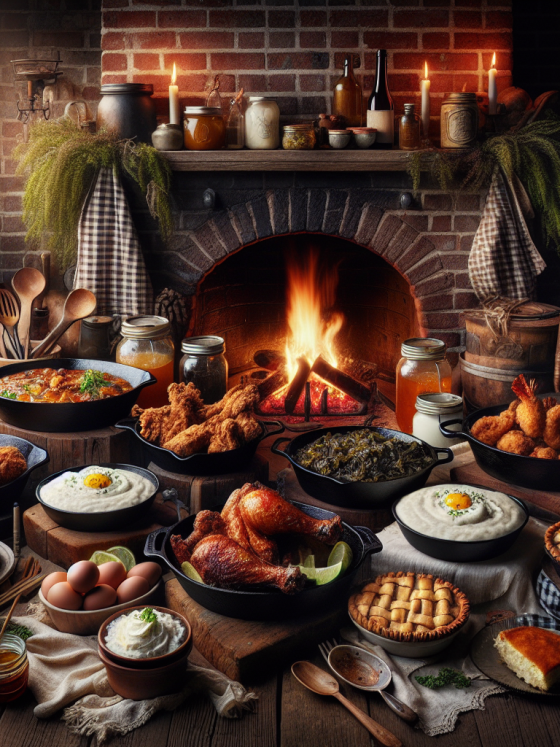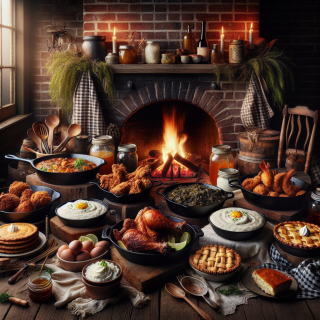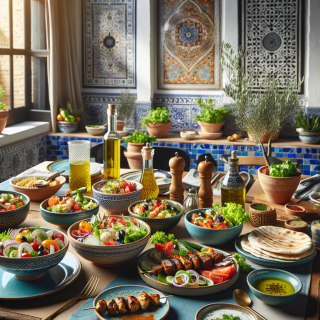Discovering the Flavors and Traditions of the Himalayan Kitchen

Himalayan cuisine is a mosaic of rich vibrant flavors that finds its base in the unique geography, variety of cultures and heritage clothing these mountainous regions. Sitting between two culinary heavyweights, India and China, Himalayan cuisine is clearly influenced by the foods these countries eat yet boasts a unique identity that has developed due to its altitude & climate as well as cultural heritage. Towering above the Himalayas, from steamed dumplings (momos) in Tibet to hearty noodle soup ‘thukpa’ in Nepal where every dish tells a tale conservation and sustainability amidst harsh living conditions of one of the toughest habitats on earth. Traditional Tsampa Porridge reflects the taste profile here, but also speaks to their sustainable living with locally sourced ingredients like yak meat and barley along with buckwheat, indigenous herbs and spices. The Himalayas kitchen is a walk more cultural than culinary; it speaks of traditions lost, community living and an ancient wisdom at the heart of these people who have thrived in glee with mother nature for centuries.
The Culinary Landscape of the Himalayas
The culinary scene of the world reflects spices, flavors and smells transcending from one country to other similarly is The Himalayas a symbiosis weaved by different cultures — bringing together elements situated on our palatesMegha. The food here in these high-altitude areas is strongly connected to the tough landscape and severe weather conditions, using strong ingredients such as barley buckwheat root vegetables.
Simplicity is the hallmark of typical Himalayan cuisine, with a few key flavors like ginger-garlic and turmeric along side locally grown herbs being used to create some unforgettable dishes. Local staples are momos (dumplings), thukpa (noodle soup) and dal bhat(lentil with rice) — healthy, nourishing & energy-rich foods to get the locals through chilly winters. Moreover, they demonstrate how innovative food preservation techniques have been refined over centuries — fermented foods like gundruk (fermented leafy greens) and chhurpi (dried cheese). The kitchen adopt Himalayan not only nurtures the body but also provide a more profound link with life cultural and spiritual of its people, mirroring their ability to live harmoniously in nature.
Geographic Diversity and Its Influence on Cuisine
The seismic activity and rich biodiversity in the Himalayan region is a major factor affecting local cuisine which makes for an interesting anecdote of flavors. The mountains stretch over India, Nepal and Bhutan as well as Tibet so the altitudes differ accordingly along with climate changes creating a wide range of fresh ingredients to choose from which through have been used only traditionally for balancing mind-body types aids digestion helps immunity Related Videosfrom Hinterland Video Face Off (21n78e): Scaling The Peaks Medical Miracles: A Matter Of Life Medical Innovation Sout.. The lower valley farmlands are lush, with fertile soil producing rice and vegetables as well as spices. These are the heavily spiced dishes — your curries or stews. On the other hand, up in the rugged high ground, food moves to heavier staples which can support life in a harsher environment. Barley, buckwheat and yak butter all have a sizeable culinary role in the region from which tsampa (roasted barley flour porridge) to momo — their now famous dumplings. Moreover, thanks to the rich endemic flora and fauna of La Vera we can taste wild herbs in some local products, like that oil or grass-fed lamb that we are going to try. This geographic diversity represents the soul of the Himalayan culinary bin, providing a diet that is both diverse and deeply connected to nature.
Key Ingredients in Himalayan Cooking
The unique and varied geography and cultural tapestry of the Himalayas give each meal a distinct character, shaping key ingredients used in cooking. Buckwheat, a common ingredient in local dishes like “piro aaalu” (spicy potatoes) and «buckwheat noodles). Another vital grain, barley is used to make the nourishing flour tsampa which also has a tea mixed into it giving you a full meal. Yak butter and yak cheese take starring roles too, lending unique flavors as well as mouthfeel to dishes like soups or dumplings called “momos.” Locally grown fiddleheads, nettles and radishes bring bright colors as well as health benefits. Cumin, coriander and turmeric add a little depth and warmth as the chili peppers bring in some fire. The inspiration behind using natural, locally-grown ingredients is not just to protect the tradition in more authentic way rather also keep it sustainable which brings original essence of eating directly from mother earth and that’s exactly what we follow at Himalayan Kitchen.
Overview of Traditional Cooking Techniques
The traditional cooking methods in the Himalayan kitchen clearly tell us about how blessed they are — culturally and traditionally rich regions, who have been dependent on what their land offers. A dominant method is cooking with open fire (using wood, cow dung as fuels) which will give a traditionally unique smokey flavour to the dishes. Tandoors —Clay ovens that are primarily used for baking a special type of breadstone, as naan and roti. Slow cooking and heavy-bottomed pots to properly deliver heat, flavoring through extended time (sometimes hours!) Also at Tibetian influenced areas, steaming is also popular such as momos (dumplings) and thukpa. One crucial process is fermentation, which you can still find in classic drinks like chhang and gundruk (a fermented leafy green vegetable). Finally, sun-drying meat and vegetables is a way of maintaining them for the coming winter which means survival in a cruel time. Together these methods embody ingenuity and a bond with the earth where simple ingredients add up to substantial, inventive dishes
Signature Dishes and Recipes
The Himalayan kitchen is as much a colorful fabric of flavors and customs, every dish an expression of the mix cultural parts in addition to its own normal fortune. True artist of the Tibetan kitchen, Momos: These small dumplings with their fragrant fillings in various wraps. The noodle soup known as thukpa is pure warming sustenance and perfectly embodies the nurturing nature of Nepali food. This is evident in the wonderfully different taste of gundruk (fermented leafy green vegetable) reflecting centuries old, age-old preservation techniques. http://ht.ly/FNjO9The regional food creations — crispy Tibetan meat pies called shapale, sweet rice-based ring-shaped bread from Nepal known as sel roti and more truly demonstrate the culinary innovation of these areas. It succeeds in paying homage to these ancient staples unique to the Himalayan people, which are rarely prepared with locally sourced ingredients and often time-honored methods. The culinary diversity of the people and traditions, as well as a sublime recognition of natural flavor synergy in these signature dishes exemplify why Himalayan kitchen is Both exquisite & decadent.
Momos – The Beloved Dumplings
Momos are not just dumplings — they are a Himalayan staple consumed in droves throughout Nepal, Tibet, Bhutan and parts of Northeastern India. Inspired by these umami-filled mouthfuls, be they stuffed with meat or veggies minced beyond recognition under a thin-smooth layer of dough that are just so versatile and homey. Although boring you way, momos can also be fried or served in a flavourful soup to suit the choice of many. They are a group experience, part of that collection process and many hands (quite literally) will be involved as they provide labor for their own food.
That simplicity is overlaid with levels of flavour sneaked in by sauces, from the fiery tomato achar dip to rounded sesame paste – among other styles. A house specialty, zhimathang (filled pastries) come stuffed with everything from silky chicken to rich yak and farm vegetables harvested from the region. A bite of momo is a taste from the soul of Himalayan cooking—no bells, no whistles, just honest flavors and full hearts.
Thukpa – Nourishing Noodle Soup
One of the (many) iconic dishes that represent a rich culinary culture originating from Himalayan states is Thukpa. Natively from the mountainous terrain of Tibet, it has successfully rooted itself into traditional kitchens in Nepal, Bhutan and several regions throughout North India. This is no ordinary bowl of noodles- It represents so much more to those in the region and the level of comfort this soup provides during cold winter days. Thukpa: One thing you have to remember whenever a food coma strikes, whether in winters or summers, thupka is your go-to meal. essentially involving garlicky ginger garlic cloves with an extensive range of regional spices mixed together that offer it the flavorsome broth taste and also enriched along with vegetables & meat so whatever suits top for them making who outside from this comprehension doubt one-sized bowl full up taking down every possible affliction our stress makes extremely versatile heartiest penis wholesome soup dish?
Every bowl of Thukpa speaks volumes about the land and its people; showcasing a beautiful partnership between easy-on-the-palate yet layered dishes as is with any other Himalayan cuisine. It differs from one locale to other, and household to households in terms of the preparation techniques followed and ingredients used therein rendering it with variations in each region. Thukpa also acts as social glue that brings families, friends together over steaming bowls of noodles and vegetables in the cold mountain environment. A bowl of Thukpa is more than just another gastronomical delight, it’s an expedition through the tastes and tales from the mountains.
Dal Bhat – Staple Rice and Lentil Dish
More than just a dish, Dal Bhat is an anchor of Himalayan cuisine, nowhere more so than in Nepal. It is a very simple and basic meal, consisting of dal (lentil soup) with bhat (boiled rice). Dal—acrosstheboard made from split red lentils—is spiced with turmeric, cumin, garlic and ginger to bring in musty warmth. Hence, the dal is nicely soaked by bhat (long-grained rice) and also it has a pl do of water from boiled lentil.
Traditionally, Dal Bhat is served with tarkari (curried vegetables) and achar (pickles), making it an all-encompassing meal that addresses the dietary requirements of high-altitude living. Most boondi that is eaten daily in Himalayan households, even twice a day (morning and evening) He assures me the simplicity of himalayan cooking. Besides being marathons, these meals are a source of camaraderie too that popularly passed amongst families in good food and spirits. Dal Bhat is more than just a nutritious meal, it symbolizes the rich heritage and traditional cordiality of Himalayan culture.
Phagshapa – Pork with Radish
Phagshapa is a gravy-like dish which has originated from the Himalayan region, more precisely Sikkim and nearby places. The richness of the pork is balanced by a slight sweetness and crunch from fresh radish in this dish that just sings. Phagshapa — This is made from boiling pork belly and then frying it with radish slices, dried red chilies, Sichuan pepper powder or other seasonings. A little chili and the turmeric provide a punch of color, hits you with warmth in this dish.
The magic lies in the simplicity, few but powerful ingredients and being a celebration of rustic Himalayan home-cooked food. Absolutely inspired by the ingenuity and straightforwardness of how dishes are made locally, because many times these are cooked up during festivals or family gatherings. What steamed rice does is help the dish to blend beautifully with rich and savory notes of stew, along with mild but earthy flavors that come from radish. Phagshapa, not only a meal but an experience that takes your taste buds on a journey to the hearty and modest culinary exports of Himalayan kitchen.
The Role of Food in Himalayan Culture and Festivals
The food and feast play a significant role in the Himachal culture and is inspired by their tradition, identity, legacy but more importantly it represents brotherhood. Cuisine is not just the source of sustenance but a vivid representation of social and spiritual life across this expansive range; from Nepal to Bhutan, in northern India as well as Tibet. Festivities are incomplete without sumptuous spreads of traditional food, which represent the very essence of local produce and ancient culinary methods. The festivities of Losar (Tibetan New Year), Dashain (Nepalese harvest festival) and Teej(an Indian monsoon festival) are also steeped in rituals, replete with food that provides physical blessings symbolic of prosperity, kinship etc. Simple varieties include dumplings, lentils and rice-based dishes along with a big collection of sweets plus breads, all having regional variety. These traditional cuisine usually come with significant meaning; for example, the Guthuk soup eaten in Losar is believed to cleanse our body and pure our soul. Therefore the kitchen of Himalayan is an important cushion and carrier which passes on beautiful tales through generations in those culinary traditions where people from their own region come together to taste flavors that honor land, food mainly around available resources they have.
Rituals and Traditions Around Food
The Himalayan food rituals and traditions are steeped into the cultural history & spirituality of these regions. The truth is, some meals are more than merely a source of sustenance; they function as sacred rituals and social traditions that have been passed down through generations. In Tibetan Buddhism, for example people make food offerings to deities and spirits as a way of expressing devotion-gratitude. Festive dishes such as Guthuk and Tsampa during Losar (Tibetan New Year) come with a great number of symbols having to do with prosperity, purification. The Newari are known for celebrating Mha Puja, a tradition that celebrates the inner self and features an elaborate feast as well to benefit physical and spiritual health. Meanwhile, Himachal Pradesh in India offers Dham—a typical wedding and religious meal featuring a series of vegetarian courses made from food sources deeply interwoven with the landscape: an emblematic illustration of peace between man and nature that has always been at the heartfelt centre piece Himalayan culinary heritage.
Common Festive Foods and Their Significance
The traditional foods of the region are very much connected to their cultural and religious traditions, they vary greatly in each area as you move around the Himalayan kitchen. A classic example of this is the momo, a dumpling filled with either meat or veggies that Tibetans — who believe they bring good fortune and family closeness if eaten at Losar (the Tibetan New Year) — like to chew on. Another household staple is a hot and hearty noodle soup called Thukpa — perfect for both cold winter nights or festive occasions.
Tihar (festival of lights), is incomplete without the traditional ring-shaped rice bread, Sel roti which symbolises prosperity and good luck. Bhutan – Ema Datshi : In Bhutan, this spicy chili and cheese stew is enjoyed throughout the country as a popular celebratory dish; showcasing their affinity for piquant flavors and eating together.
These foods are more than just edible pleasures; they come with tradition and culture, food that was cooked from an ancestral recipe passed down through the family in years of existence on this Earth. Every dish has a story — humbling, enlightening and definitely celebrating the resilience, resourcefulness and colorful tapestry of cultures Himalayan people are made-up!
Community and Hospitality Practices
In the Himalayan region with all its colourful cultural backgrounds community and hospitality feature highly in each place along with traditional cuisine. The kitchen is the soul of these high-altitude neighborhoods, and it strengthens people through warmth, acting as a catalyst for both innovation and celebration. Food served is not just for serving the food, it helps in bringing people closer and gives you a feeling of home. Offered meals are exquisitely prepared for guests, generally following an appetizer and several small courses made up of regional ingredients such as yak butter; barley liquor; green vegetables harvested in season.
That said, there are other forms of hospitality found throughout the Himalayan region but with one common theme each — respect for guests who they consider as blessings. The rich biodiversity of the region as well its spiritual ethos is reflected in elaborate feasts that accompany festive occasions, community gatherings and religious ceremonies. For Tibetan butter tea, it means a hearty bond of warmth—Ara for the Bhutanese is a token shared in homage to guests. They continue to support the belief in Himalayan culture that food sharing and serving others are a vital expression of social interdependence.
Preserving Traditional Himalayan Foods in Modern Times
In the era of modernization, preserving traditional Himalayan staple foods is a catch-22 as one needs to find a fine-line between age-old quality and newer technologies. Its Himalayan cuisine, with yak butter in the diet besides barley and local herbs; meet indigenous flavors that capture the very essence of a region’s cultural soul. There are several ways to protect and maintain this tradition through various initiatives such as culinary tourism, local food festivals, farm-to-table movements etc. We also support educational programs that will pass along the ancient art of traditional cooking to later generations while documenting recipes and techniques, so these culinary practises do not die out. Moreover, use of traditional foods in the healthy trend will improve biodiversity and agricultural sustainability practices. The world has been getting globalized and with it the influx of various cuisines but this return evolution is a great breeding ground to showcase / conserve what distinctly flavors these Himalayan hinterlands. Attempts to commemorate and incorporate these ancient culinary methods will maintain the vitality of Himalayan cuisine in a modern world.
Challenges of Modernization
Modernization poses a huge threat to the rich culinary heritage of Himalayan region Time-honored practices and recipes, handed down over generations, may also get crowded out with the deluge of fast food and global cuisine. The shift is attributed to urbanization, evolution in lifestyle and preference of youth towards convenience. This is an alarming trend that puts at risk the long-term conservation of unique Himalayan ingredients and culinary practices.
More than that, modernization can be synonymous with the decline in local food which results back to a lower demand for organic and traditional farming supported by centuries. Commercialization of food production puts emphasis on efficient (usually with the most profit) mass production and not in maintaining traditional flavors or nutritional values. Moreover, the globalisation of taste and spread of processed food may serve to erode diet diversity characteristic of Himalayan cuisine traditions.
To do, this it is imperative to have a concerted effort of documenting the traditional food that chefs and cooking experts are capable enough to make in the Himalaya so as to not only celebrate but also promote its offerings. This shifts to reviving interest in indigenous dishes, assisting local producers and harmonising ancient methods with modern living.
Efforts to Sustain Culinary Heritage
Maintaining the Himalayan culinary heritage is multi pronged, with heaping doses of tradition and cultural savvy ensuring continued relevance across time. Communities with the help of locally rigorous culinary historians and ethnographers are preparing to document their traditional recipes, techniques that have been carried mother-to-daughter for generations. Community-based tourism and food festivals are essential components in telling the story of these one-of-kind dishes to an unfamiliar audience — who need those narratives for a reason not just to understand but also help sustain them. There is also a growing interest in sustainable, and organic farming to ensure the authenticity (untainted from modern agricultural practices) of ingredients for Himalayan cuisine. We have also offered programs for our youth to remind them not only of their culinary roots, but how important it is they take pride in and continue these traditions. These collective steps are important for the survival of both the flavors and traditions extracted from Himalayan kitchen, in order to sustain globalization rapid change in daily life.
Influence of Himalayan Cuisine Globally
The world has increasingly been impacted by Himalayan cuisines. Himalayan cuisine with its own set of locally available ingredients like yak meat, buckwheat flour and a range endemic herbs spices serves as an entire different canvas on the global culinary radar. Items such as momos (dumplings), thukpa (noodle soup) and dried gundruk leaves have spread across the region, winning fans in major global metropolitan areas. At the same time, wellness trends have brought Himalayan cuisines into focus for their natural and organic ingredients and balanced nutrition paths. Moreover, with the growth of restaurants serving Himalayan cuisine around the world and international food festivals — in Berlin or Austin — exposing more people to some of these techniques and flavors that characterize this diverse culinary tradition. The influence of Himalayas is not limited to food alone, with an overall emphasis on cultural awareness for sustainability and a holistic approach that helps in deeper understanding which reminds one of the life at those mountains.
So what have we concluded?
To conclude, a culinary journey through the Himalayan kitchen is lot more than just dining out; it feels like you are living a part of their rich canvas-culture. Secret recipes passed down from generation to generation by the inhabitants of these mountains that offer us their treasures in each dishANNOTATIONS A tale of ancient traditions, local products and a common heritage for every community living together at 1000 meters hight on impressive mountaintops. Every taste, from the Thukpa giving comfort whilst gathering around warmth and community to complex millennia old culinary wisdom hidden within fermentation — brings a piece of life in Himalayas back with it. From meals that make your mouth water to a new level of respect for the fine line between tradition and innovation in Himalayan cuisine, this culinary journey is guaranteed to please. In an ultimate sense tasting those flavors from Himalaya and exploring the cuisines is a cultural lesson that declares this crucial bond between location, climate, locals with their cuisine. It is an offering to enjoy the simple things in life and a toast to honor what’s left of Himalayan culture.







